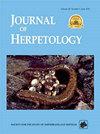Delayed Effects of Nutrients in the Larval Environment on Cope's Gray Treefrogs (Hyla chrysoscelis) Exposed to Batrachochytrium dendrobatidis
IF 0.8
4区 生物学
Q3 ZOOLOGY
引用次数: 1
Abstract
Abstract. Excess nutrient runoff can profoundly alter aquatic habitats and has been associated with changes in host–pathogen interactions. Floating macrophyte mats have been suggested as a management strategy to improve water quality for aquatic communities and, thus, may have the potential to protect hosts from some disease outbreaks. We assessed the impact of ammonium nitrate and sodium phosphate addition in the presence or absence of floating macrophyte mats (blue flag iris [Iris versicolor] and ice dance sedge [Carex morrowii]) on Cope's Gray Treefrog (Hyla chrysoscelis) metamorphosis to examine whether macrophyte management treatments improve outcomes for amphibians. At metamorphosis, we infected individuals with the amphibian chytrid fungus, Batrachochytrium dendrobatidis (Bd), to assess whether larval treatments resulted in differential susceptibility to this pathogen. We found that nutrient addition significantly increased time to metamorphosis without affecting mass at metamorphosis or survival. Additionally, Bd exposure decreased mass of juvenile treefrogs, regardless of earlier larval environment or condition at metamorphosis. Macrophyte addition had no direct impact on larval anurans, but the aquatic community was altered via fluctuations in aquatic nutrient concentrations. Overall, our study suggests that nutrient exposure and Bd infection individually affect anurans, and larval exposure to nutrients may have latent effects on metamorphosed anurans that could affect future fitness.幼虫环境中营养物质对树蜡虫感染Cope’s Gray Treefroggs(Hyla chrysoscelis)的延迟效应
摘要过量的养分径流会深刻地改变水生栖息地,并与宿主-病原体相互作用的变化有关。漂浮的大型植物垫已被建议作为改善水生群落水质的管理策略,因此,可能有可能保护宿主免受某些疾病爆发的影响。我们评估了在存在或不存在漂浮的大型植物垫(蓝旗鸢尾[iris versicolor]和冰舞莎草[Carex morrowii])的情况下添加硝酸铵和磷酸钠对Cope’s Gray Treefrog(Hyla chrysoscilis)变态的影响,以检查大型植物管理处理是否能改善两栖动物的结果。在变态时,我们用两栖类壶菌Batrachochytrium dendrobatidis(Bd)感染个体,以评估幼虫处理是否导致对这种病原体的不同易感性。我们发现,营养物质的添加显著增加了变态的时间,而不影响变态时的质量或生存。此外,无论早期幼虫的环境或变态条件如何,Bd暴露都会减少幼年树蛙的数量。大型植物的添加对无尾幼虫没有直接影响,但水生营养物质浓度的波动改变了水生群落。总的来说,我们的研究表明,营养物质暴露和Bd感染分别影响无尾虫,幼虫暴露于营养物质可能对变态无尾虫产生潜在影响,这可能会影响未来的健康状况。
本文章由计算机程序翻译,如有差异,请以英文原文为准。
求助全文
约1分钟内获得全文
求助全文
来源期刊

Journal of Herpetology
生物-动物学
CiteScore
1.60
自引率
0.00%
发文量
45
审稿时长
6 months
期刊介绍:
The Journal of Herpetology accepts manuscripts on all aspects on the biology of amphibians and reptiles including their behavior, conservation, ecology, morphology, physiology, and systematics, as well as herpetological education. We encourage authors to submit manuscripts that are data-driven and rigorous tests of hypotheses, or provide thorough descriptions of novel taxa (living or fossil). Topics may address theoretical issues in a thoughtful, quantitative way. Reviews and policy papers that provide new insight on the herpetological sciences are also welcome, but they must be more than simple literature reviews. These papers must have a central focus that propose a new argument for understanding a concept or a new approach for answering a question or solving a problem. Focus sections that combine papers on related topics are normally determined by the Editors. Publication in the Long-Term Perspectives section is by invitation only. Papers on captive breeding, new techniques or sampling methods, anecdotal or isolated natural history observations, geographic range extensions, and essays should be submitted to our sister journal, Herpetological Review.
 求助内容:
求助内容: 应助结果提醒方式:
应助结果提醒方式:


